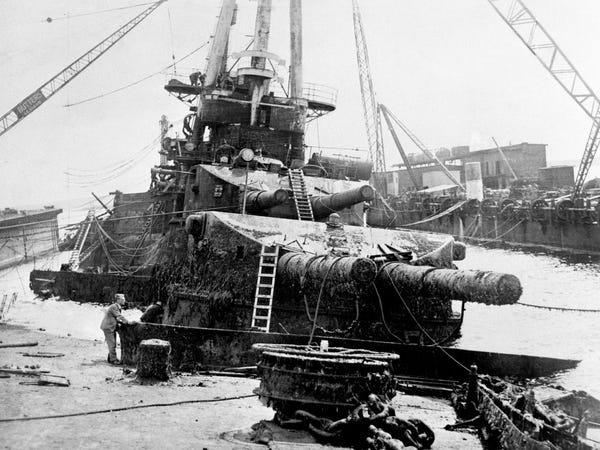## Press Start on a Nuclear Comeback? ☢️
Remember those ’80s action movies where robots with glowing eyes and radioactive waste were the ultimate threats? Turns out, the future might not be quite as bleak as those blockbusters painted it.

Nuclear power, once the villain of the hour, is staging a comeback – and this time, it’s not just about dodging Meltdown Mondays.
Business Insider is reporting on a surge in interest from consultants, who see a bright future for the industry. Think advanced reactors, cleaner energy, and maybe even a shot at tackling climate change.

Standardization and Replication: Unlocking Cost Savings and Speed

Nuclear energy has the potential to be one of the cleanest and most reliable forms of energy on Earth, according to experts from the Boston Consulting Group (BCG). The construction of nuclear reactors in the United States is lagging compared to efforts in China and elsewhere, a trend that consulting firms are searching to reverse by cutting costs, improving efficiencies, and removing obstacles holding up progress.
The efficiency of construction is a key area of focus for BCG, with the firm stating that a “simpler design” is the key to success. This approach involves following a “design-for-manufacturing” approach, which has delivered compelling results in other industries such as aerospace and defense.
The goal is to standardize the components and material needed for construction, reducing the number of construction steps and promoting “modularity.” This approach applies to both large-scale and small-scale reactors, according to Benjamin Vannier, managing director and partner at BCG.

Benefits of Standardization
- Cost savings: Standardization can lead to significant cost savings by reducing the complexity of construction and the need for specialized labor.
- Improved efficiency: Standardized designs can be built more quickly and with less waste, resulting in improved efficiency and reduced environmental impact.
- Increased reliability: Standardized designs can also lead to increased reliability, as the same components and materials are used across multiple reactors.
- French and German nuclear programs: The nuclear programs in France and Germany in the 1970s and 1980s are examples of successful standardization, with the two countries adopting similar designs and construction methods.
- Chinese nuclear program: China’s rapid expansion of its nuclear program is another example of successful standardization, with the country adopting a standardized design for its reactors and achieving rapid construction times and low costs.
- US Navy nuclear program: The US Navy’s nuclear program is also an example of successful standardization, with the Navy adopting a standardized design for its reactors and achieving high levels of reliability and efficiency.
Examples of Successful Standardization
Navigating the Challenges: Obstacles to Widespread Adoption
Despite the potential benefits of nuclear energy, there are several challenges that must be addressed in order for the industry to achieve widespread adoption.
Cost and Timelines: Balancing Ambitions with Reality
One of the major challenges facing the nuclear industry is the high cost of construction and the long timelines associated with building a new reactor.
Nuclear reactors require a significant upfront investment in time and money, which can be a barrier to entry for many companies and governments.
Additionally, the construction process is often plagued by delays and cost overruns, which can further exacerbate the financial burden.
Regulatory Hurdles: Streamlining the Approval Process
Another challenge facing the nuclear industry is the regulatory hurdles that must be overcome in order to build a new reactor.
The approval process for a new reactor can be lengthy and complex, involving multiple government agencies and stakeholders.
Streamlining the approval process and reducing the regulatory burden could help to speed up the development of new reactors and make the industry more competitive.
Public Acceptance: Addressing Concerns and Building Trust
Finally, there is the challenge of public acceptance, with many people expressing concerns about the safety and environmental impact of nuclear energy.
Addressing these concerns and building trust with the public will be essential for the long-term success of the nuclear industry.
This can be achieved through education and outreach efforts, as well as by demonstrating the safety and reliability of nuclear reactors through real-world examples and data.
The Economics of Scale: Can Nuclear Power Deliver on its Promise?
One of the key questions facing the nuclear industry is whether it can deliver on its promise of providing clean and reliable energy at a competitive price.
Market Potential: Reaching a Sustainable Share of Energy Generation
The nuclear industry has the potential to play a significant role in meeting the world’s growing energy demands, particularly in regions with limited access to fossil fuels.
However, the industry must be able to deliver on its promise of providing clean and reliable energy at a competitive price in order to achieve widespread adoption.
This will require significant investment in research and development, as well as improvements in efficiency and cost competitiveness.
Job Creation and Economic Impact: The Ripple Effect of Nuclear Growth
The nuclear industry has the potential to create significant numbers of jobs and stimulate local economies through the construction and operation of new reactors.
According to a study by the Nuclear Energy Institute, the nuclear industry supports over 400,000 jobs in the United States alone, with many more created through the supply chain and related industries.
The growth of the nuclear industry could also have a positive impact on local economies, particularly in regions with limited access to other forms of energy.
The Role of Government Policy: Incentivizing Investment and Innovation
The Role of Government Policy: Incentivizing Investment and Innovation
Government policy plays a critical role in incentivizing investment and innovation in the nuclear industry.
Policymakers can create a favorable business environment by offering incentives for companies to invest in nuclear energy, such as tax credits, low-interest loans, and guaranteed prices for electricity.
Additionally, governments can provide funding for research and development, as well as support for small and medium-sized enterprises (SMEs) that are working on innovative nuclear technologies.
By creating a supportive policy environment, governments can help to accelerate the growth of the nuclear industry and reduce the costs associated with building new reactors.
Examples of Successful Government Policy
- France’s nuclear program: France’s nuclear program is often cited as a model for successful government policy, with the government providing significant funding and support for the industry.
- China’s nuclear program: China’s nuclear program has also received significant government support, with the government providing funding and incentives for companies to invest in nuclear energy.
- US nuclear policy: The US government has also taken steps to support the nuclear industry, including providing funding for research and development and offering tax credits for companies that invest in nuclear energy.
These examples demonstrate the importance of government policy in supporting the growth of the nuclear industry and reducing the costs associated with building new reactors.
Challenges and Opportunities
While government policy can play a critical role in supporting the growth of the nuclear industry, there are also challenges and opportunities to be considered.
One challenge is the need to balance the need for government support with the need to maintain a level playing field for all companies in the industry.
Another challenge is the need to ensure that government support is targeted effectively and that it reaches the companies and technologies that are most in need of support.
Opportunities for government policy include the potential to create jobs and stimulate local economies through the construction and operation of new reactors.
Additionally, government policy can help to address concerns about the safety and environmental impact of nuclear energy by providing funding for research and development and supporting the development of new technologies.
Conclusion
The nuclear industry has the potential to play a significant role in meeting the world’s growing energy demands, particularly in regions with limited access to fossil fuels.
However, the industry must be able to deliver on its promise of providing clean and reliable energy at a competitive price in order to achieve widespread adoption.
To achieve this, the industry will need to focus on reducing costs, improving efficiency, and addressing concerns about safety and environmental impact.
Government policy will also play a critical role in supporting the growth of the nuclear industry, by providing incentives for companies to invest in nuclear energy and supporting the development of new technologies.
By working together, the nuclear industry and governments can help to create a sustainable and secure energy future for all.
This will require significant investment in research and development, as well as improvements in efficiency and cost competitiveness.
However, the potential rewards are significant, and the nuclear industry has the potential to play a major role in meeting the world’s growing energy demands.
Conclusion
So, it seems the future of nuclear power is looking brighter than a spent fuel rod. Consultants predict a resurgence of this controversial energy source, fuelled by rising global energy demand, climate change concerns, and advancements in reactor technology. The article paints a picture of a nuclear renaissance, driven by factors like smaller, safer modular reactors and the growing recognition of nuclear’s role in decarbonizing economies. While risks remain, the potential benefits – reliable baseload power, reduced carbon emissions, and energy independence – are enticing enough to make this sector a serious contender in the global energy landscape.
But what does this mean for us, the gamers? Imagine a future where your console runs on clean, virtually limitless energy, powered by efficient nuclear reactors. Picture sprawling, immersive virtual worlds fueled by the very same energy source that powers our cities. This isn’t science fiction; it’s the potential reality shaping up on the horizon.
The future of gaming is inextricably linked to the future of energy. As we strive for more immersive and demanding experiences, the need for sustainable power sources becomes paramount. Nuclear power, with its potential to reshape the energy landscape, could very well become the unsung hero powering our next generation of gaming adventures. The question is, are we ready to embrace this power?
The Role of Government Policy: Incentivizing Investment and Innovation
Government policy plays a critical role in incentivizing investment and innovation in the nuclear industry.
Policymakers can create a favorable business environment by offering incentives for companies to invest in nuclear energy, such as tax credits, low-interest loans, and guaranteed prices for electricity.
Additionally, governments can provide funding for research and development, as well as support for small and medium-sized enterprises (SMEs) that are working on innovative nuclear technologies.
By creating a supportive policy environment, governments can help to accelerate the growth of the nuclear industry and reduce the costs associated with building new reactors.
Examples of Successful Government Policy
- France’s nuclear program: France’s nuclear program is often cited as a model for successful government policy, with the government providing significant funding and support for the industry.
- China’s nuclear program: China’s nuclear program has also received significant government support, with the government providing funding and incentives for companies to invest in nuclear energy.
- US nuclear policy: The US government has also taken steps to support the nuclear industry, including providing funding for research and development and offering tax credits for companies that invest in nuclear energy.
These examples demonstrate the importance of government policy in supporting the growth of the nuclear industry and reducing the costs associated with building new reactors.
Challenges and Opportunities
While government policy can play a critical role in supporting the growth of the nuclear industry, there are also challenges and opportunities to be considered.
One challenge is the need to balance the need for government support with the need to maintain a level playing field for all companies in the industry.
Another challenge is the need to ensure that government support is targeted effectively and that it reaches the companies and technologies that are most in need of support.
Opportunities for government policy include the potential to create jobs and stimulate local economies through the construction and operation of new reactors.
Additionally, government policy can help to address concerns about the safety and environmental impact of nuclear energy by providing funding for research and development and supporting the development of new technologies.
Conclusion
The nuclear industry has the potential to play a significant role in meeting the world’s growing energy demands, particularly in regions with limited access to fossil fuels.
However, the industry must be able to deliver on its promise of providing clean and reliable energy at a competitive price in order to achieve widespread adoption.
To achieve this, the industry will need to focus on reducing costs, improving efficiency, and addressing concerns about safety and environmental impact.
Government policy will also play a critical role in supporting the growth of the nuclear industry, by providing incentives for companies to invest in nuclear energy and supporting the development of new technologies.
By working together, the nuclear industry and governments can help to create a sustainable and secure energy future for all.
This will require significant investment in research and development, as well as improvements in efficiency and cost competitiveness.
However, the potential rewards are significant, and the nuclear industry has the potential to play a major role in meeting the world’s growing energy demands.
Conclusion
So, it seems the future of nuclear power is looking brighter than a spent fuel rod. Consultants predict a resurgence of this controversial energy source, fuelled by rising global energy demand, climate change concerns, and advancements in reactor technology. The article paints a picture of a nuclear renaissance, driven by factors like smaller, safer modular reactors and the growing recognition of nuclear’s role in decarbonizing economies. While risks remain, the potential benefits – reliable baseload power, reduced carbon emissions, and energy independence – are enticing enough to make this sector a serious contender in the global energy landscape.
But what does this mean for us, the gamers? Imagine a future where your console runs on clean, virtually limitless energy, powered by efficient nuclear reactors. Picture sprawling, immersive virtual worlds fueled by the very same energy source that powers our cities. This isn’t science fiction; it’s the potential reality shaping up on the horizon.
The future of gaming is inextricably linked to the future of energy. As we strive for more immersive and demanding experiences, the need for sustainable power sources becomes paramount. Nuclear power, with its potential to reshape the energy landscape, could very well become the unsung hero powering our next generation of gaming adventures. The question is, are we ready to embrace this power?